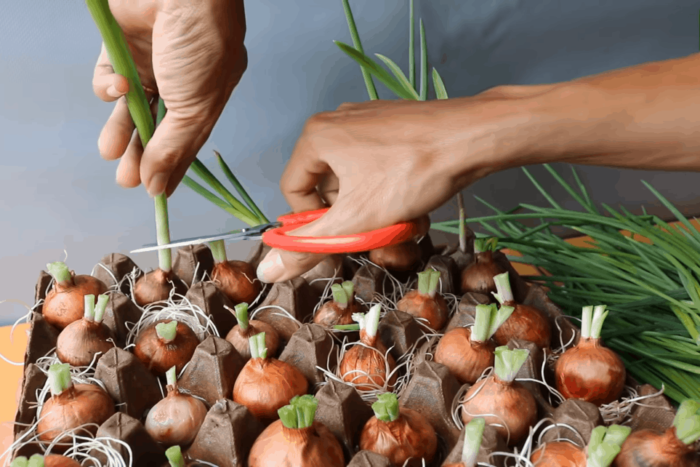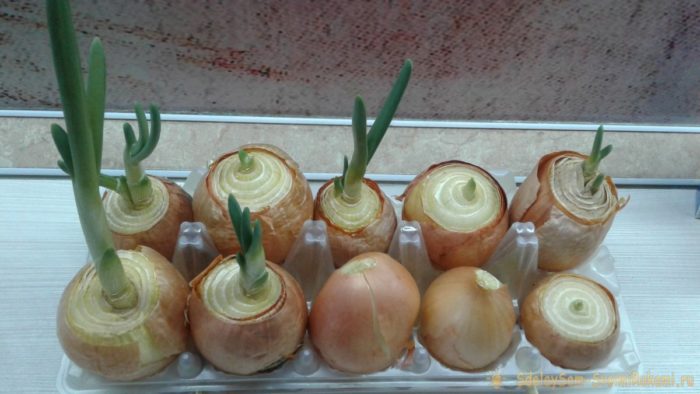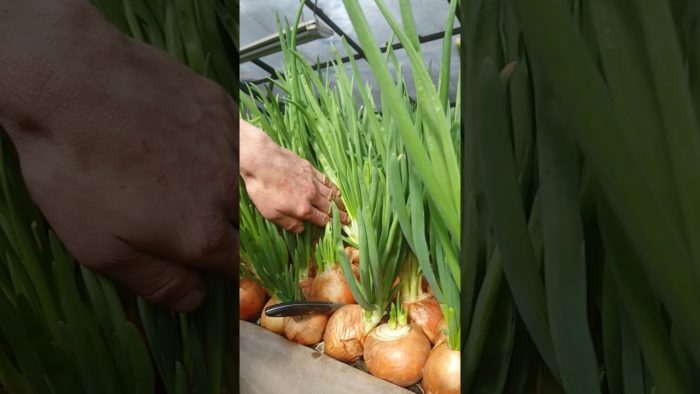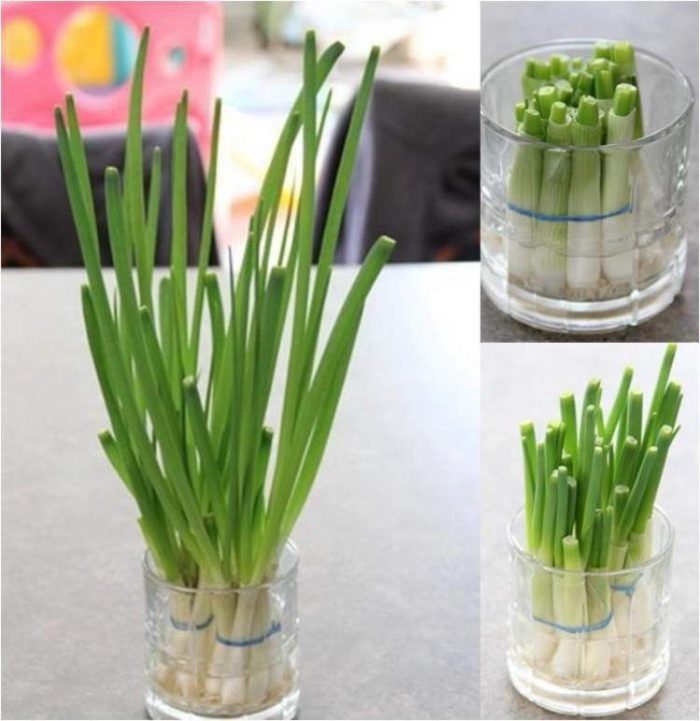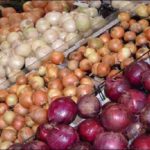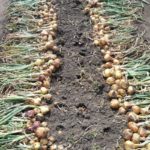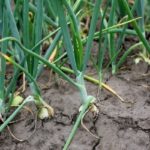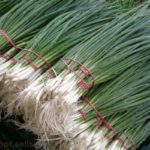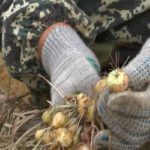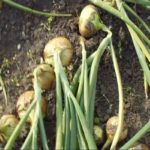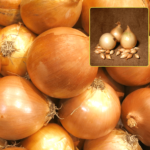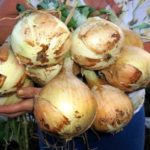Green onions are a delicious summer ingredient in salads, soups, and okroshka. Usually they are cut or plucked off every day for lunch, sometimes a whole bunch is collected at a time and sold. Unsystematic and massive pruning of feathers negatively affects their further growth and the condition of the vegetable. There are various methods on how to cut onions correctly and not damage the plant.
- Cutting onions for greens: when and how often can this be done
- Preparing onions for cutting: rules and recommendations
- Proper cutting of onions for greens
- Mass cutting of onions below the growing point
- Mass cutting of onions above the growing point
- Plucking individual onion feathers
- Conditions under which onions will continue to grow after cutting
- Using onions that have grown after cutting
- Number of onion greens: how many times can this be done?
- Common mistakes when cutting onions for greens
Cutting onions for greens: when and how often can this be done
If the vegetable is grown for sale, there is no need to cut off the feathers in advance. They fade quickly. Greens from the garden bed are ready for pruning when they grow to 15 centimeters in length. At this stage of growth, the feathers are pleasant to taste and juicy. In addition to length, dry and lightened tips are a sign that it is time to cut off the feathers. But such “old” stems are tougher and less juicy in taste.
How often fresh onion greens will be on the table depends on the method of their extraction and the type of vegetable. If you pinch off 2-3 feathers from the garden every day, the bulbs will quickly make up for the loss. After pruning at the root, the green part will not grow back this year, and the vegetable will lose nutrients and weaken.
The best suppliers of greens are onion varieties that produce abundant green shoots:
- "Aristocratic";
- "Cipoluccio";
- "Old Russian";
- "Stuttgarten Riesen";
- "Lilac ringing."
Famous types of onions also produce feathers: shallots, leeks, slime, chives. Green stems appear from the end of June on vegetables planted in spring. Greens also grow on winter onions.
Preparing onions for cutting: rules and recommendations
Onion planting needs to be prepared only for a radical change in image. Completely cutting off the green top will stress the vegetable, so the bed will require additional care and feeding.
How to prepare onions for trimming:
- thin out the planting;
- remove dried, thin and weak stems;
- check the health of the planting, get rid of specimens with signs of disease.
After simple preparatory measures, the greens can be cut off completely. After pruning, the beds must be fertilized with fertilizers containing nitrogen.
Proper cutting of onions for greens
Feathers play an important role in the nutrition of the bulb. They contain vitamins and microelements for each layer of the vegetable. Arrows and seeds form on the stems.
Bulbs with developed peduncles are small, quickly deteriorate and are not suitable for harvesting for the winter. Vegetables should be eaten immediately after flowering. Two or three flowering bulbs are enough for propagation. Feathers from vegetables intended for storage for future use must be trimmed.
It is important to trim onions correctly because the shelf life of the vegetable also depends on this. A bulb without shoots may rot and become soft. When cutting in bulk, the stems must be cut off with a sharp knife. Rarely pinching off young elastic feathers will not harm the bulb, but completely removing the greens in this way will injure the vegetable.
Mass cutting of onions below the growing point
The most unfavorable method for the future of the onion bed is to trim the feathers to the very bottom, to the top layer of the bulb. In this case, the vegetable is deprived of a part from which a new feather could be formed. The cut site remains untreated and wet, which leads to damage to the bulb.
Vegetables with stems cut below the growing point are suitable for food, but not for storage. New greenery will no longer appear on them. Therefore, summer residents dig up the cut bulbs and throw some away.
To get another harvest of greens, you need to plant the onion bed again. The only advantage of the cutting method is the large number of green feathers.
Mass cutting of onions above the growing point
The most favorable way to satisfy the summer resident’s appetite and the future fate of the vegetable is to cut the stems so that green “stumps” remain on the bulb. Cutting above the growing point has several advantages:
- a bountiful harvest of greenery;
- the bulbs will put out new stems;
- vegetables will not spoil and will be suitable for storage.
The method is also suitable for collecting onion feathers every day for lunch.
The specific position of the growth point of the stems is difficult to determine, so it is easier to leave 1 centimeter from the green stem on the bulb. With this method, the layers of the vegetable are not damaged, so rotting is excluded. The bed will not need to be replanted.
Plucking individual onion feathers
The peculiarity of the growth of arrows is that they grow unevenly on simultaneously planted bulbs. Some appear earlier, others later. Some arrows are longer, some are shorter. In this case, there is no need to mow all the green growth.
Let the hatched shoots stretch upward, and older stems can be plucked off. Stems suitable for cutting reach a length of 15 centimeters or more.
Plucking off individual feathers is suitable for collecting onion greens for personal needs: seasoning borscht or soup, cutting into a salad or for pie filling, just eating with salt. In this case, it is better not to break off the stem, but still cut it with a sharp knife or scissors.
Conditions under which onions will continue to grow after cutting
The main condition is that there is no damage to the bulb. To do it, it is enough not to cut off the greens completely, leaving a few millimeters of the stem. Subsequent growth of onions depends on care, which includes:
- moderate watering;
- solar warmth and light;
- fertilizing after pruning.
Onions are grown for greenery in an apartment on the balcony or in the kitchen. The bed is planted in containers, pots, and various plastic containers.A home garden requires the same support as a country garden: keep the onions in a well-lit place, make sure that the soil does not dry out or become moldy from moisture, and do not rush to cut off young shoots.
In order for the bed to turn green again as quickly as possible, it is necessary to apply fertilizers with nitrogen. An aqueous solution of mullein or bird droppings is best.
Using onions that have grown after cutting
The bulbs grow in the ground for 2.5-3 months. During this time, the arrows are grown and harvested. Then it's time to harvest the onions. Usually this is the end of July or the beginning of August.
Vegetables are stored for storage, having previously prepared:
- cleared of earth;
- dry in the sun for two weeks;
- trim the roots and remaining feathers;
- the strongest specimens without flaws are selected.
Onions are stored in a dry place at a temperature from 0 to +3 degrees. It is also marinated and dried from chopped onion rings. Only healthy onions are suitable for storage and consumption. Watery dark spots on the neck, soft layered part, mucus on the scales, white coating on the bottom - signs of disease.
Number of onion greens: how many times can this be done?
Feathers appear 6-8 days after planting the onion. The vegetable is planted in late May or early June. The first harvest of greens can be harvested by July. The number of harvests per season depends on the cutting method:
- below the growth point - one;
- above the growth point - 2-3 collections;
- pinch off as it grows - unlimited quantity.
In an apartment on a windowsill, onions can be grown in winter, in a pot or in water. Then the green feathers will be ready for the table all year round.
Common mistakes when cutting onions for greens
A sign of improper collection is poor growth and stunted appearance of feathers, as well as their absence and damage to the bulb.Cutting greenery leads to a sad outcome in the following cases:
| Error | Consequence | How to avoid |
| Feathers are trimmed below the growth point | Lack of new greenery
Onion rotting |
Leave a small part of the stem above the onion neck |
| Uneven cut | Healing torn edges takes more energy from the plant | Cut off the stems with a sharp tool |
| Wrong choice of landing site | Greenery does not develop due to lack of light | Move the bed to a lighted area |
| Early pruning | The bulb lacks nutrients if the young feathers are immediately cut off | Trim the stems when they reach 15-20 centimeters in length |
| Improper watering | A strong jet from a watering can or hose knocks down feathers | Water the onions with a spray bottle |
| Lack of nutrition | Feathers grow weak | Feed with fertilizers containing nitrogen. |
After the first cut, the ability of the bulbs to produce feathers weakens. Therefore, it is important to fertilize the garden bed and allow the new stems to grow sufficiently.

